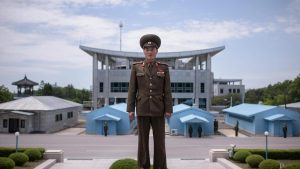Much of the world views Friday’s inter-Korean summit as a warm-up act for the main show, the “headliner” scheduled for some weeks hence between Donald Trump and Kim Jong-un. But there is reason to see the summit between South Korean President Moon Jae-in and North Korea’s Mr Kim as the first part of a two-act play, with both halves crucial to the story that ultimately unfolds.
For it’s doubtful if the Trump-Kim meeting would have even been on the cards without the two Koreas relentlessly driving a peace process.
Remember, they did so against all odds. When the two Koreas undertook direct bilateral negotiations in January, it was after months of terrible threats and imprecations from Mr Trump. He had promised “fire and fury” against North Korea, declared the US was “locked and loaded” and even announced that America would have no choice but to “totally destroy” North Korea.
The US president’s belligerence did not cease even after Mr Kim made his now game-changing New Year’s Day address, in which he offered to enter conditional talks with South Korea and send a delegation to the Pyeongchang Winter Olympics. In fact, Mr Trump responded to the North Korean leader’s reference to the “nuclear button” physically installed on his desk in inimitable fashion. He tweeted: “I too have a nuclear button, but it is a much bigger & more powerful one than his and my button works!”
That same day, Mr Kim reopened a direct cross-border communication channel with South Korea for the first time in nearly two years. It was a response to Seoul’s quick embrace of the slightest prospect of talks with North Korea, despite Mr Trump accusing Mr Moon of “appeasement”. The Trump administration continued to dismiss the nascent bonhomie on the Korean peninsula. Nikki Haley, US ambassador to the United Nations, insisted the US would not take high-level interaction seriously unless North Korea abandoned its nuclear arsenal. And Mike Pompeo, Mr Trump’s choice for secretary of state, expressed scepticism about inter-Korean talks.
As we now know, South Korea wisely kept its counsel and persisted. So it transpired that Mr Kim sent athletes, cheerleaders, singers — as well as his sister — to the Winter Games, where they were churlishly ignored by US vice president Mike Pence before South Korea delivered an invitation from Mr Kim for a meeting with Mr Trump. It was accepted, laying the ground for the second act.
But the first act — the inter-Korean summit — is enormously significant. Clearly, it was a stubborn survivalist instinct that kept the two Koreas talking. It served a common interest, to prevent US military intervention on the peninsula, an all-out war, the possible use of nuclear weapons and millions dead.
So they kept talking even as they felt their way towards a vague outline of a peace process. The outline still remains vague, just three days before Mr Moon and Mr Kim meet for the first such summit in 11 years. There is talk of finally calling time on the Korean War that ceased in 1953 but was never formally ended. Beyond that, the choreography for the summit in Panmunjom in the Korean Demilitarised Zone is unclear.
What is clear is that South Korea is the first steadfast American ally to demonstrably pursue its own diplomatic path on a pressing local matter that could evolve into a regional or global crisis. It is obvious that Seoul was rattled by Mr Trump’s repeated threats to renege on American security commitments. Or perhaps it was wounded by the suggestion US protection must be paid for by the beneficiary — or it could be that Mr Moon, a former human rights lawyer whose parents fled from North Korea during the Korean War, truly believes the two Koreas should at least be at peace if not re-united.
As for Mr Kim, his motivation may lie in desperate cunning — to seek a loosening of crippling new economic sanctions; to lull the world into dealing with North Korea like any other country; to leverage nuclear capability into trade, aid and recognition as a de facto nuclear state.
Whatever the reasons, both Seoul and Pyongyang have, for the moment, united against Mr Trump’s apparent disinclination to serve their shared interest. But the sequence of startling events and near hits and misses on the Korean peninsula offer a larger lesson too. Christopher Preble, vice president for defence and foreign policy studies at the conservative Cato Institute in Washington DC, recently diagnosed the inter-Korean diplomatic process as a sign of the “changing shape of global power”. America is still the richest country but much poorer than after the Second World War. It is still the most militarily powerful country but new technologies allow small and relatively weak ones to challenge the US. Finally, there is Mr Trump’s “America First” policy, which does not inspire confidence among allies.
Depend upon it: the first act of the Korean play is key.


